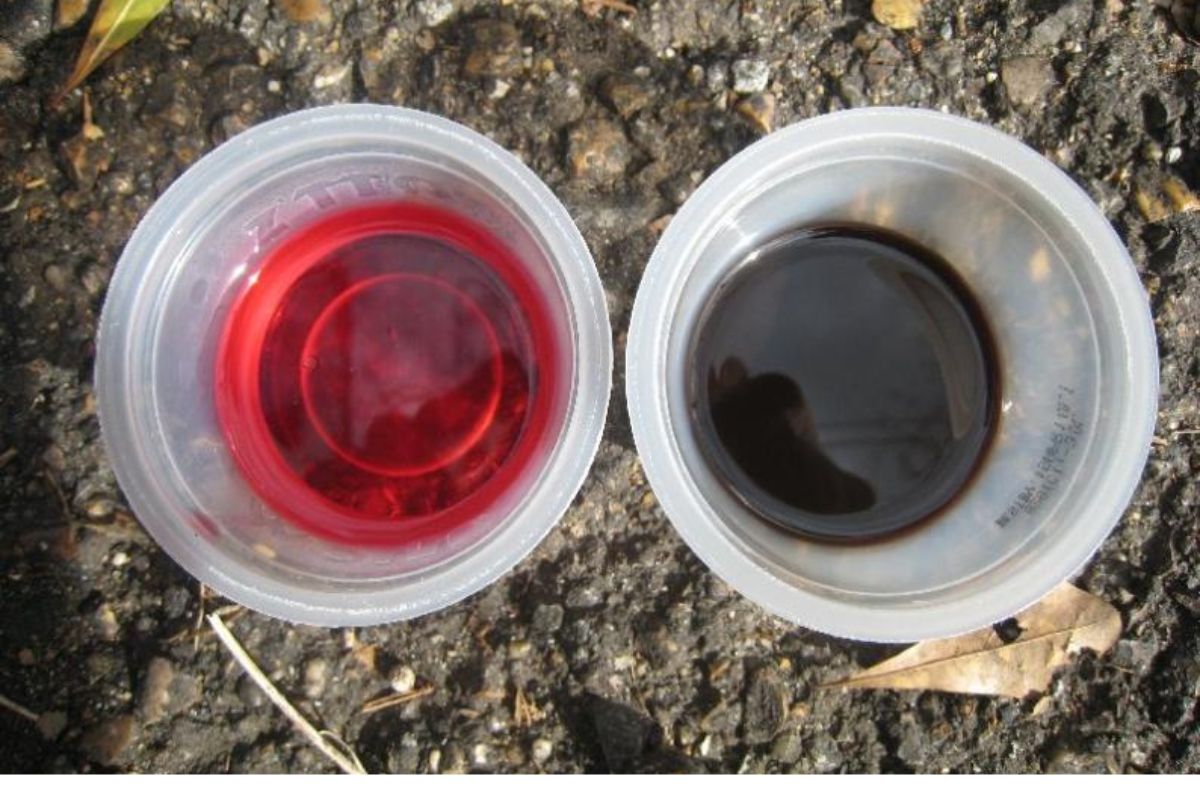Common Causes of Black Transmission Fluid
If you recently noticed that you have black transmission fluid in your car, you’re probably looking for answers. This discoloration might be a warning sign of deeper issues underneath the surface and can lead to serious problems with your vehicle if not sorted out quickly. In this blog post, we’ll cover the common causes of why transmission fluid would turn black so that you can get closer to understanding what exactly is going on under the hood.
We’ll discuss how to properly check oil levels and spotting early signs of trouble, as well as how regularly scheduled maintenance checks ensure a better driving experience in terms of road safety and performance. So read on – it’s time to gain some expert insight about black transmission fluid!
What Does It Mean When Transmission Fluid Is Black
1. Oxidation
Is your transmission fluid dark brown or even black? It’s vitally important to address this concern immediately, as it can signal the need for a flush and replacement. The transition in color is a result of the fluid oxidizing – a process that drastically impacts its overall effectiveness.
When left untreated, oxidation in the fluid can compromise the efficiency of your transmission and potentially result in costly repairs.
2. Low Transmission Fluid Levels
The first and most common cause of black transmission fluid is inadequate levels of oil in the transmission system. This can be due to a leak caused by damaged seals or worn-out gaskets, but it can also be simply because the car is not being serviced correctly and regular oil top-ups are not taking place.
Low levels of transmission fluid mean that the various components that make up your car’s transmission have to work harder, resulting in overheating – which leads us onto our next point…
Related: Low Transmission Fluid Symptoms
3. Overheated Components
If your vehicle has been overworked for a long period of time without adequate lubrication or servicing, then it could lead to transmission components becoming overheated – resulting in discoloration of the oil.
This can be due to a wide range of issues, from an old or inefficiently functioning transmission system, to worn-out parts that need replacing or repair work.
4. Contamination From External Sources
In some cases, black transmission fluid could be caused by contamination from external sources, such as dirt and grime entering the system through cracks and holes in the vehicle’s bodywork.
If your car is regularly subjected to dusty roads and trails then this could result in unwanted particles making their way into the transmission system – leading to a build-up of sludge and ultimately causing discoloration of the fluid itself.
5. Internal Issues With The Transmission System
Finally, black transmission fluid could be caused by underlying issues inside the transmission system. These might include worn-out components or damaged seals and gaskets, which can all lead to oil leaks and wear-and-tear of other parts.
In these cases it is important to take your car in for a professional diagnosis so that any necessary repairs can be carried out before further damage is done.
Black Transmission Fluid: The Measures You Can Take

It’s easy to feel overwhelmed when you discover that your vehicle’s transmission fluid has turned black and appears tar-like, or even worse, emits a burning odor. However, don’t panic; there are measures that you can take to address this issue.
1. Clean The Entire System
One of the most effective solutions is to thoroughly clean the entire transmission system. Start by safely dropping the pan and draining the old fluid completely. Be sure to replace the filter as well, since that may also have been compromised. When filling the new filter, use only the type of fluid specifically recommended in your Owner’s Manual.
Remember, using the wrong type of fluid is a recipe for disaster, as it can lead to further damage to the transmission system.
2. Don’t Do Flushing
It is crucial to avoid flushing the black fluid, as this approach can do more harm than good. Flushing can force dirt and larger debris particles into the small spaces within the transmission system, exacerbating the problem.
Furthermore, there is a risk of dislodging intricate components from delicate transmission parts, potentially causing significant and costly damage.
3. Never Refill A Dirty Transmission System
Dealing with a troublesome black transmission fluid in a vehicle with over 150,000 miles can be quite a challenging task, especially when the fluid smells burnt and has thickened with visible deposits. The integrity of the entire transmission system comes into question and simply refilling with new fluid may prove to be a risky move.
Unknown to many, this seemingly harmless act can cause severe damage to the entire transmission system, to the extent that it could fail completely.
How To Properly Check Oil Levels
To learn more about how to properly check oil levels, you can find all the information you need right here. By reading this article, you’ll discover a step-by-step guide that will help you accurately check your oil levels and ensure that your engine is running smoothly.
Additionally, you’ll learn about the importance of regular oil changes and how they can help maintain your vehicle’s performance and increase its lifespan.
Related: How To Check Your Oil?
FAQs about Common Causes of Black Transmission Fluid
1. What color is bad transmission fluid?
A well-performing fluid should appear relatively clear or have a pink hue to it. However, if you notice that your transmission fluid has turned deep red or brown, you should be aware that it has aged and is potentially causing extra damage within your transmission. Even more alarmingly, if the fluid appears dark brown, this likely signifies that it has become burnt due to overheating.
2. What Colour should transmission fluid be?
The ideal hue of the transmission fluid is a translucent dark red color, signifying that it is healthy and ready to protect your car’s internal components. This dark red coloration is a result of the dye added to the fluid, making its visual inspection a breeze for vehicle owners and mechanics alike.
3. What does dirty transmission fluid mean?
Imagine driving along and suddenly feeling like your car is struggling to pick up speed or stay in gear. This can often be a sign that your transmission fluid is dirty or contaminated, meaning excess dirt and other impurities have infiltrated the fluid, causing a loss of hydraulic power.
This unclean fluid can severely impact the essential flow and pressure required for your vehicle’s transmission to remain in the appropriate gear.
4. Can I drive with dirty transmission fluid?
Driving with dirty transmission fluid might not seem like a big deal initially, but did you know that it can lead to costly consequences in the long run? The transmission is constantly at work, shifting hundreds of times while you drive.
Each time a shift happens with dirty transmission fluid, your vehicle experiences a subtle shudder. While this may be easy to ignore, doing so can put your car at risk of damaging its gears. Over time, this continuous wear and tear can strip the gears, causing you to face an expensive repair job.
Conclusion
The takeaway from this blog post is that black transmission fluid could be a sign of worry, but it doesn’t necessarily mean an emergency. By understanding the causes behind discoloration, you can spot potential issues early on and address them before more serious damage occurs.
However, if you want to be certain that your transmission system is in good shape and functioning properly, then it’s best to consult a professional mechanic and have them carry out a full service check. They’ll be able to make sure that all parts of your car are running smoothly and advise you on any maintenance or repairs that may need to be done.

I’m Timothy Ballard, owner of a used car dealership in Springfield. I love just about everything automotive, but I have a special place in my heart for trucks. I’m an ASE Certified Master Technician, so I know my way around a car. In my spare time, I enjoy traveling with my family and hiking new trails.

Transmission fluid that is nearly black or black indicates that it is old, heavily contaminated, and has oxidized if accompanied by a burnt toast smell. These signs indicate a problem with your transmission. Additionally, if your transmission is exhibiting slipping or hesitation, it may require repair or replacement.